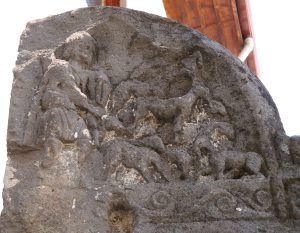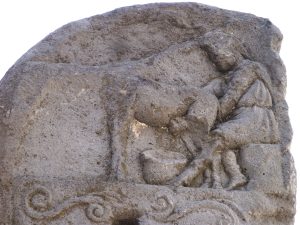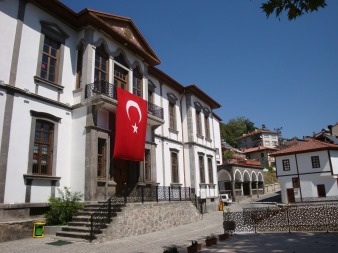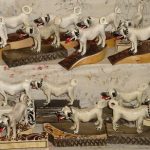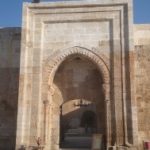Capital of Melik Ahmed Gazi Population: 37,000
Old name: Cabira, Diospolis, Sebaste, Neocaesarea
Market day:
Less than an hour’s drive north of Tokat, Niksar was, from 1077 to 1117, the capital of the Danışmends, a Selçuk offshoot led by Melik (King) Gümüştekin Ahmed Gazi, who had served under Kılıçarslan and received this area as a personal fiefdom in return.
The town sits in a valley and climbs the slopes on either side. It’s dominated by the remains of a huge castle although one should probably take with a pinch of salt claims that it’s the country’s second largest.
Several early mosques can be found in the lower part of town where there are also many Ottoman houses that are being rapidly restored by what looks like a pretty go-ahead local authority.
Must-sees: Ulu Cami, Kale Kapısı, Kale, Melik Gazi Türbesi, Belediye building, Çöreği Büyük Cami
Time on your hands: Kırkkızlar Kümbeti, Taş Mektep, Clocktower
About town
If you arrive by minibus you’ll be dropped near the Kelkit (ancient Lycos) river which is crossed by a pair of pretty stone-arched bridges, one called the Leylekli Yılanlı Köprüsü (Stork and Snake Bridge, 11th century) because of the carving on its keystone. Two restored Ottoman teahouses overlook the river, as do some equally attractive modern ones. There’s also a large metal waterwheel although it’s no longer turning.
 Start climbing up towards the Kale (Castle) and your path should take you past the Çöreğı Büyük Cami which dates back to the 14th century period of İlhan occupation. It has a wonderful Selçuk-style portal – note the unusual carving of a sitting deer immediately above the missing inscription plate. The interior has been disappointingly restored to look like the inside of a sauna cabin.
Start climbing up towards the Kale (Castle) and your path should take you past the Çöreğı Büyük Cami which dates back to the 14th century period of İlhan occupation. It has a wonderful Selçuk-style portal – note the unusual carving of a sitting deer immediately above the missing inscription plate. The interior has been disappointingly restored to look like the inside of a sauna cabin.
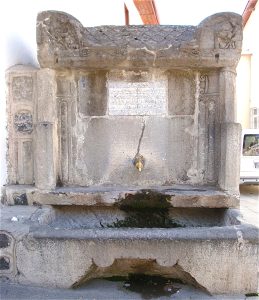
Right beside the mosque is one of Niksar’s many fine çeşmes (fountains). The Lülecizade Çeşmesi was only erected in 1921 but its top was made out of a sarcophagus taken from old Neocaesarea – look for the images of a shepherd and his sheep in one corner and a man milking a cow in the other.
If you keep walking you will start to see stretches of the low wall of the castle. The Büyük Hamamı was built right against it but nothing now remains.
Around the Kale Kapısı (Castle Gate) several towers survive to quite a height and incorporate bits of old Roman masonry, including a sarcophagus lid. As at Fener in İstanbul houses are built right up against the walls.
Immediately across the road from the Kale Kapısı is the Ulu Cami, the main mosque, that dates back to 1145 when it was built for the Danışmend Çepnizade Hasan Bey in typically Selçuk low-slung style with one tall minaret.
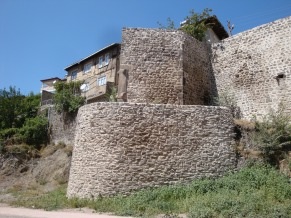 From here you can follow the steep path up to the Kale which is now a large park/tea garden scattered with pieces of masonry from all periods of Niksar’s history. Remains of a hamam survive and the Danışmend-era Yağıbasan Medrese dating back to 1157 has been restored to serve as a restaurant with balconies overlooking fine views of Niksar’s red-tiled roofs. A replica kümbet (tomb) has been built to serve as a mescid (chapel).
From here you can follow the steep path up to the Kale which is now a large park/tea garden scattered with pieces of masonry from all periods of Niksar’s history. Remains of a hamam survive and the Danışmend-era Yağıbasan Medrese dating back to 1157 has been restored to serve as a restaurant with balconies overlooking fine views of Niksar’s red-tiled roofs. A replica kümbet (tomb) has been built to serve as a mescid (chapel).
From the Ulu Cami you can instead climb the equally steep hill to the graveyard where Melik Ahmed (AKA Danişmend Gazi, d. 1104) was buried in a simple tomb with colourful calligraphy on the walls. Also buried in the graveyard are members of the Tacettinoğulları family who founded a beylik around Niksar in the 14th century. Look out, too, for the attractive 12th-century Kolag Kümbeti built to house the remains of Süleyman Şah’s son Aslan Kutalmış.
Once you’re finished with the graveyard stroll back downhill into the town centre and look for the magnificent building at the top of a flight of marble steps that houses the local Belediye. In front of it the Belediye Çeşmesi is another of the town’s fine fountains reusing old Roman stonework. Beside it the pretty little stone porticoed Taş Mektep (Stone Primary School) has been restored to house a library.
Scattered about town are many fine Ottoman houses that are slowly being restored. One of the finest is the Taş Bina Konağı (Stone Mansion) which retains some original ceilings and painted wooden cupboard doors. 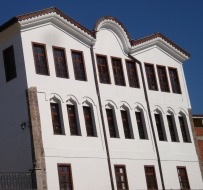
Finally, you might want to walk uphill behind the modern clocktower to find the Kırkkızlar Kümbeti (40 Maidens’ Tomb, 1220) about which predictably pretty stories are spun. In comparison with the lavishly decorated kümbets in Niğde and Kayseri, however, it’s a fairly prosaic structure.
Sleeping
For a better choice of hotels you can visit Niksar on a day trip from Tokat or Amasya.
Nuri Park Hotel. Tel: 0356-528 3030
Otel İpek Palas. Tel: 0356-527 2602
Tokat Burçu Otel: 0356-533 256 4260
Yazmacılar Hanı Otel: Tel: 0356-212 1211
Transport info
There are hourly minibuses to Niksar (54km) from Tokat‘s town-centre underground minibus terminal. The journey takes about an hour through attractive arable countryside.
